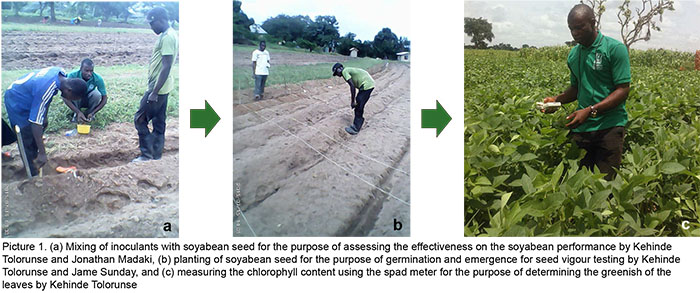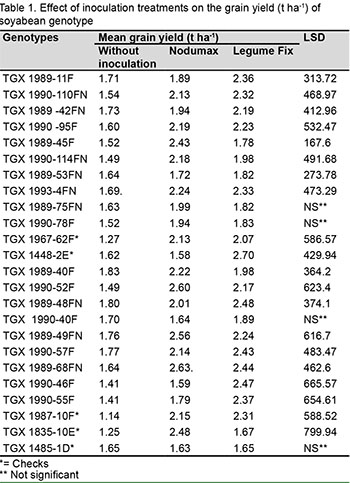Despite the importance of soyabean in Nigeria, yields on farmers’ fields have remained relatively low. The crop holds considerable potential for arresting soil fertility decline and enhancing household food nutrition. Therefore, this study aimed to exploit differences among soyabean genotypes, assess genotype environment effect on seed yield and rhizobia inoculation as a means of improving nitrogen fixation and productivity of soyabean across three locations in the savanna region of Nigeria.

24 soyabean genotypes, including five commercial checks, were evaluated across three different agro-ecological zones in northern Nigeria. The inoculants Legume Fix and Nodumax were used in each location. Inoculation was assessed at three levels; without inoculation, Legume Fix and Nodumax. These therefore resulted into 72 (24 x 3) treatment combinations. A split-plot design with 3 replications per treatment was adopted at each location, resulting into 216 (72 × 3) plots. The main plots consisted of the soyabean lines and the sub-plots were the inoculant applications.
|
Significant differences were observed for all traits except number of leaves and days to 50% flowering. Soyabean grain yield for the 24 genotypes ranged from 1.14 t ha-1 – 1.83 t ha-1 (Table 1). Grain yield of environments ranged from 1.39 t ha-1 in Gwarzo to 2.15 t ha-1 in Abuja and was significant in all the three locations, except Gwarzo (data not shown). Inoculation significantly influenced grain yield, except in TGX 1989-75FN, TGX 1990-78F, TGX 1990-40F and TGX 1485 –1D (Table 1). Two soyabean genotypes (TGX 1989-45F and TGX 1989-40F) were identified as the overall best in performance in relation to yield and stability. Inoculation of soyabean prove positive, as it enhanced yield across the environments. Inoculated genotypes showed superiority over non-inoculated across the three environments. Kehinde Tolorunse, Federal University of Technology, Nigeria |
 |
